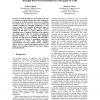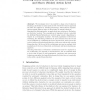GECCO
2010
Springer
13 years 9 months ago
2010
Springer
The majority of work in the field of evolutionary robotics concerns itself with evolving control strategies for human designed or bio-mimicked robot morphologies. However, there ...
EH
2003
IEEE
13 years 10 months ago
2003
IEEE
We have been studying the techniques for evolutionary robotics and experimenting with various robots applied evolutionary methods. We have paid special attentions to real robots a...
CIG
2005
IEEE
13 years 10 months ago
2005
IEEE
Several attempts have been made in the past to construct encoding schemes that allow modularity to emerge in evolving systems, but success is limited. We believe that in order to c...
IWINAC
2007
Springer
13 years 10 months ago
2007
Springer
We investigate how it is possible to shape robot behaviour adopting a molecular or molar point of view. These two ways to approach the issue are inspired by Learning Psychology, wh...
GECCO
2007
Springer
13 years 10 months ago
2007
Springer
Biologically inspired designs can improve the design of artificial agents. In this paper we explain and explore the role of directional light sensors from an Evolutionary Robotic...



